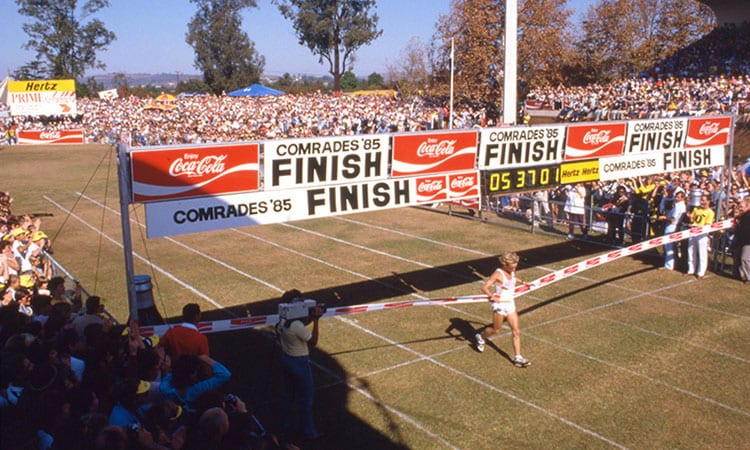
Bruce Fordyce may be the greatest runner you’ve never heard of. In fact, it’s no exaggeration to say Fordyce is to ultrarunning what Michael Jordan is to basketball. The South African is best known as the nine-time champion of the world’s largest ultramarathon, his nation’s 89 km (56 mile) Comrades Marathon, having won the “Ultimate Human Race” eight consecutive years from 1981–1988 and again in 1990. But while Jordan retired briefly from basketball to pursue a short-lived baseball career, Fordyce skipped Comrades in 1989 to set a then-world record at the 100 km distance. He also set the 50 mile world record in 1983 in 4:50:21, a mark that still stands to this day.
With an unassuming demeanor and slight physique that belies his athletic dominance, Fordyce doesn’t stand out in a crowd the way many modern athletes do. But what he lacks in physical presence and braggadocio, he makes up for with an approachable personality, keen wit and high-energy conversational style. And though he doesn’t seek out the spotlight, Fordyce was gracious enough to let us shine our own on him, on topics ranging from Comrades to country to his current passion. Because given his unique perspective as an elite athlete, one-time political provocateur and — aside from golfer Gary Player — the most recognizable sports figure of the apartheid era, there’s no better spokesman for either South Africa or the Ultimate Human Race.
RR: Catch us up on what you’re up to these days?
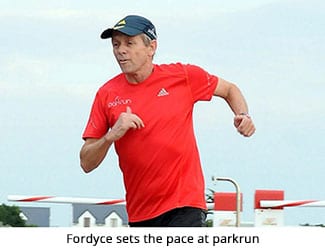 BF: I am still running but not well, having lost a lot of the cartilage in my right knee. However, I still run a couple of marathons and ultras each year, e.g. the Two Oceans Marathon in Cape Town. I give lots of coaching advice and occasionally commentate for races. I also write for a couple of newspapers and am a motivational speaker.
BF: I am still running but not well, having lost a lot of the cartilage in my right knee. However, I still run a couple of marathons and ultras each year, e.g. the Two Oceans Marathon in Cape Town. I give lots of coaching advice and occasionally commentate for races. I also write for a couple of newspapers and am a motivational speaker.
But the single greatest drive in my life, and for me the most important contribution I have ever made, is the phenomenal running movement called parkrun. parkruns are free timed 5 km runs or walks held every Saturday. parkrun started in South Africa just six years ago with 26 people, and we now have 125 parkruns around the country in which 35,000–40,000 people participate weekly. Close to 700,000 registered parkrunners have joined, and next year we will be a million strong. parkrun is set to become the most important recreational activity globally, and it will sweep through the US in the next few years. Go to www.parkrun.co.za for more information.
RR: As you continued to win Comrades year after year in the 1980s, what motivated you to keep coming back?
BF: Winning is addictive, so I kept coming back for another “hit.” And Comrades itself is addictive because it makes you proud of yourself — you don’t believe you can do it and then you do! The history and tradition draw you in to be part of it. The “up” and “down” runs, the Green Numbers and the different medals for different finish times all attract people to the race. That’s why I have run 30 Comrades. Very few runners run just one.
(Editor’s note: Established in 1921, the Comrades Marathon is rich in history and tradition. Among its traditions are 1) a course that reverses direction in alternate years to feature a more uphill profile one year (the “up” run) and a more downhill profile the next (the “down” run); 2) green bib numbers awarded in perpetuity to runners who have completed ten or more Comrades Marathons — your Green Number is yours to keep, forever; and 3) six distinct classes of medals awarded based on finish time, for times ranging from top-10 finisher (gold medal) to sub-12 hour finisher (Vic Clapham medal, named for the race’s founder). For more information on Comrades history and tradition, we recommend Bruce’s “Fordyce Diaries.”
RR: Which of your Comrades performances are you most proud of, and why?
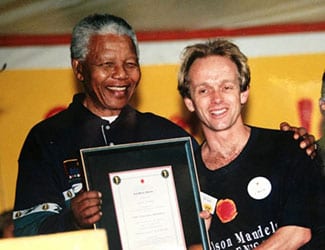 BF: I am proud of all my Comrades runs, but probably my 1981 win is the one of which I am proudest. I wore a black armband to protest against Comrades agreeing to be part of the 20th anniversary celebrations of the apartheid (National Party) government that year. Along the way I was abused and booed and was also pelted with tomatoes and eggs. My phone was tapped and the security police began to shadow me. But I won and took eight minutes off the course record. I was a very unhappy winner, but looking back I feel very proud. Nelson Mandela and the political prisoners on Robben Island were amazed that there were white sportsmen who supported them (I wasn’t the only one wearing an armband). And in 1997 President Mandela awarded me the State President’s Gold Award for Sport.
BF: I am proud of all my Comrades runs, but probably my 1981 win is the one of which I am proudest. I wore a black armband to protest against Comrades agreeing to be part of the 20th anniversary celebrations of the apartheid (National Party) government that year. Along the way I was abused and booed and was also pelted with tomatoes and eggs. My phone was tapped and the security police began to shadow me. But I won and took eight minutes off the course record. I was a very unhappy winner, but looking back I feel very proud. Nelson Mandela and the political prisoners on Robben Island were amazed that there were white sportsmen who supported them (I wasn’t the only one wearing an armband). And in 1997 President Mandela awarded me the State President’s Gold Award for Sport.
RR: What non-Fordyce Comrades performance or moment do you find most memorable/impressive?
BF: Without a doubt the late, great Wally Hayward’s 1988 up run is the single greatest Comrades achievement of all time. Wally won the Comrades Marathon five times in its early days, but in 1988 he finished in 9:44 at the age of 79. Most runners would sell their soul for a sub-10 hour finish! (Editor’s note: In 1989 at age 80, Wally Hayward finished in 10:58:03 to beat the cutoff time by one minute, 57 seconds and become the oldest finisher in Comrades history, a title he still holds today.)
RR: What was it like being one of your nation’s most recognizable athletes during the apartheid-induced sporting boycott of South Africa in the 1980s?
BF: I was recognized here and there, but not in the same way as modern sportsmen and women. Because of the country’s isolation due to the boycott, South Africans turned inwards and we watched our own sport. Comrades was and still is broadcast live for 12 hours, and South Africans settle down to watch for the full 12 hours. That was great coverage for me back in the 1980s. (Editor’s note: The 12-hour cutoff at Comrades annually boasts among the highest television ratings in the country.)
RR: Similarly, how was it to run as an amateur athlete, back before the big-money payouts of today’s races?
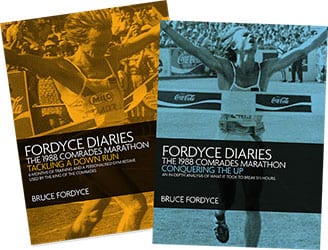 BF: It would have been nice to win some prize money, but becoming a Comrades champion in South Africa is a badge of honour for life so it wasn’t that critical. I was able to continue my work as an archaeologist in those days — I earned my master’s degree in Iron Age South African archaeology and then worked with Bushman/San rock art as a research officer at the University of the Witwatersrand — and still find lots of time to train. I also picked up some endorsements and television advertisements.
BF: It would have been nice to win some prize money, but becoming a Comrades champion in South Africa is a badge of honour for life so it wasn’t that critical. I was able to continue my work as an archaeologist in those days — I earned my master’s degree in Iron Age South African archaeology and then worked with Bushman/San rock art as a research officer at the University of the Witwatersrand — and still find lots of time to train. I also picked up some endorsements and television advertisements.
RR: Tell us about your race-day strategy of coming from behind rather than leading from the front. Did that ever backfire on you, and what can middle- and back-of-the-pack runners learn from your mindset?
BF: I didn’t really attack from behind, it was just that I had a deep internal mindset of what pace I could set for the entire distance and what pace I could maintain. It was rather that my opponents came back to me as they “died”in the last quarter of the race. In 1990 I ran the second half of the race exactly one second faster than the first half. I did run a couple of races with a faster second half, but in both the up and down directions the second half is easier so I was probably holding even effort.
[Noted South African sports physiogist and author] Tim Noakes believes that the best pace setters in marathons have an “internal governor” in their brains that is closest to that which our hunter–gatherer ancestors had. As an ex-archaeologist I can appreciate that. Going out hard from the gun very rarely succeeds — look at the race Ryan Sandes had at this year’s Western States 100 Mile Endurance Run with the American ultra runner Jim Walmsley. Everyone hero-worships Walmsley for his gutsy courageous running… but he doesn’t win! In fact he doesn’t even finish. The only time I saw “flat out” from the gun work was [Kenyan] David Rudisha’s astonishing world record win in the 2012 Olympic 800 metre final, and that was two 400 m laps with no hills. Even our own amazing Wayde van Niekerk, the current world record holder and Olympic champion in the 400 m, keeps a little bit back in the first 200 m.
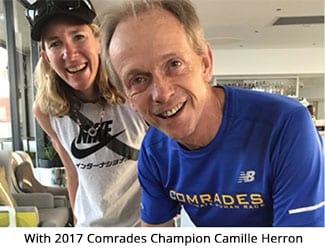 RR: Speaking of fellow countryman Ryan Sandes, what do you think of his winning America’s most prestigious ultramarathon in the Western States 100, three weeks after American Camille Herron won South Africa’s most prestigious ultra in Comrades?
RR: Speaking of fellow countryman Ryan Sandes, what do you think of his winning America’s most prestigious ultramarathon in the Western States 100, three weeks after American Camille Herron won South Africa’s most prestigious ultra in Comrades?
BF: I was delighted for Ryan. He was/is a deserving winner of Western States. If you’re going to be nutty enough to run 100 mile races, Western States is the most famous race. Camille is a delightful champion and a wonderful addition to the Comrades “winners club.” She is full of fun, runs very bravely but doesn’t seem to take it too seriously. And she partied up a storm at my after-party the day after the race.
RR: Aside from the number of runners and the sheer size of the event, how has Comrades changed and evolved in the 40+ years you’ve been involved?
BF: The race has changed so much: the size of the field, the prize money, qualifying standards etc. Luckily the traditions haven’t: Green Numbers, Max Trimborn’s cockerel crow, different medals for different finish times, etc.
(Editor’s note: At the 1948 Comrades Marathon, runner Max Trimborn let loose with his rendition of a crowing rooster to alert spectators and fellow runners that it was dawn and the race was about to start. By popular demand, Max continued the tradition until his death in 1985, and to this day his recorded cockerel crow starts every Comrades Marathon.)
RR: What was it like to experience the Ultimate Human Race as a spectator this year? Any plans to run it again?
BF: I loved being a spectator and can’t wait to do that next year. I had an amusing moment at the halfway point in Drummond when I bumped into four-time winner Alan Robb. We were both drinking coffee and he said to me, “Bruce, I’ve just realized that this is the first time we have been together at Drummond and we’re not racing each other flat out!” I would love to try and run the 100th Comrades in a few years time. (Editor’s note: Comrades will celebrate its 100th running in 2025.)
RR: What would you tell the novice runner who is intrigued by the challenge of Comrades but thinks, “I can’t possibly run 89 km in less than 12 hours”?
BF: Tens of thousands of nervous novices have said the same to themselves. Ten of thousands have succeeded. Comrades is a wonderful adventure from the months of training to the race itself. The day after Comrades you are not the same person you were before. It is a positive life-altering experience.
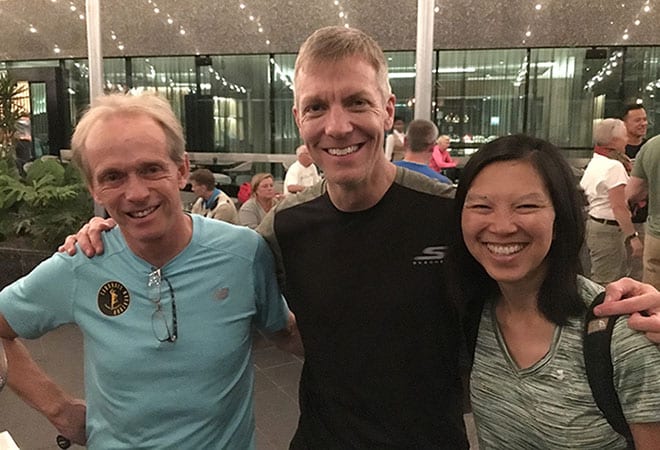
For more information on parkrun and to find a parkrun near you (or to learn how to host your own!), go to parkrun.com.
Who better to help you train and prepare for the Comrades Marathon than a nine-time winner? Check out both editions of the “Fordyce Diaries” — “The 1986 Comrades Marathon: Tackling a Down Run” and “The 1988 Comrades Marathon: Conquering the Up” — available now as ebooks at brucefordyce.com.
Contact Fordyce directly through his blog or email him at [email protected].
And read reviews from Comrades finishers on our Comrades Marathon race page.
Find this article informative or entertaining? Please share it, and let others know RaceRaves is the premier online resource to DISCOVER, REVIEW & TRACK all their races and to CONNECT with other runners!
Other RaceRaves articles you’ll enjoy (trust us!):
Comrades Marathon: The race every runner should run
Best Bets for a Boston Qualifier (Oct-Mar)
Best Bets for a Boston Qualifier (Apr–Sept)
Toughest Road Marathons in North America
Unconventional Races that dare to be different
10 Presidential Races of the U.S. (PROTUS)
Getting to know the Abbott World Marathon Majors
5 Half Marathon Series worth a full look
And for more helpful articles, check out our blog!
No comments yet